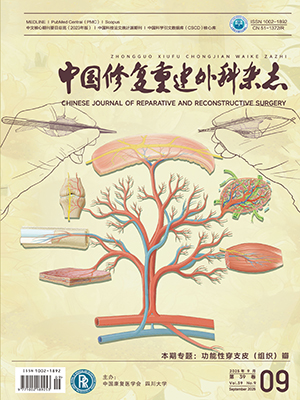Objective To investigate the effect of repairing bone defect with tissue engineered bone seeded with the autologous red bone marrow (ARBM) and wrapped by the pedicled fascial flap and provide experimental foundation for cl inical
appl ication. Methods Thirty-two New Zealand white rabbits (male and/or female) aged 4-5 months old and weighing
2.0-2.5 kg were used to make the experimental model of bilateral 2 cm defect of the long bone and the periosteum in the radius. The tissue engineered bone was prepared by seeding the ARBM obtained from the rabbits on the osteoinductive absorbing material containing BMP. The left side of the experimental model underwent the implantation of autologous tissue engineered bone serving as the control group (group A). While the right side was designed as the experimental group (group B), one 5 cm × 3 cm fascial flap pedicled on the nameless blood vessel along with its capillary network adjacent to the bone defect was prepared using microsurgical technology, and the autologous tissue engineered bone wrapped by the fascial flap was used to fill the bone defect. At 4, 8, 12, and 16 weeks after operation, X-ray exam, absorbance (A) value test, gross morphology and histology observation, morphology quantitative analysis of bone in the reparative area, vascular image analysis on the boundary area were conducted. Results X-ray films, gross morphology observation, and histology observation: group B was superior to group A in terms of the growth of blood vessel into the implant, the quantity and the speed of the bone trabecula and the cartilage tissue formation, the development of mature bone structure, the remolding of shaft structure, the reopen of marrow cavity, and the absorbance and degradation of the implant. A value: there was significant difference between two groups 8, 12, and 16 weeks after operation (P lt; 0.05), and there were significant differences among those three time points in groups A and B (P lt; 0.05). For the ratio of neonatal trabecula area to the total reparative area, there were significant differences between two groups 4, 8, 12, and 16 weeks after operation (P lt; 0.05), and there were significant differences among those four time points in group B (P lt; 0.05).
For the vascular regenerative area in per unit area of the junctional zone, group B was superior to group A 4, 8, 12, and 16 weeks after operation (P lt; 0.05). Conclusion Tissue engineered bone, seeded with the ARBM and wrapped by the pedicled fascial flap, has a sound reparative effect on bone defect due to its dual role of constructing vascularization and inducing membrane guided tissue regeneration.
Citation: YANG Xinming,SHI Wei,DU Yakun,MENG Xianyong,YIN Yanlin. EXPERIMENTAL STUDY OF REPAIRING BONE DEFECT WITH TISSUE ENGINEERED BONE SEEDED WITH AUTOLOGOUS RED BONE MARROW AND WRAPPED BY PEDICLED FASCIAL FLAP. Chinese Journal of Reparative and Reconstructive Surgery, 2009, 23(10): 1254-1259. doi: Copy
Copyright © the editorial department of Chinese Journal of Reparative and Reconstructive Surgery of West China Medical Publisher. All rights reserved




